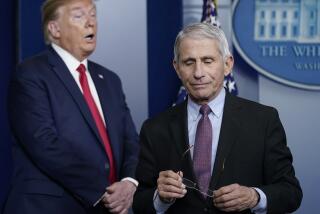Ozone Researcher to Head National Science Group
- Share via
UC Irvine chemist F. Sherwood Rowland, who discovered that man-made chemicals were eroding the Earth’s protective ozone layer, has been elected president of one of the nation’s largest scientific organizations on a platform critical of “big project” science.
Rowland was chosen by mail-in balloting to head the American Assn. for the Advancement of Science, university officials announced Wednesday. The AAAS, which has about 130,000 members who represent a broad range of scientific disciplines, publishes the prestigious journal, Science. The magazine will formally announce his election in its December issue.
Rowland, 63, beat out Massachusetts Institute of Technology President Paul E. Gray for the post, but AAAS officials declined to divulge the number of votes each candidate received.
Gray, 58, an electrical engineer who has headed the prestigious university since 1980, made the need to improve scientific literacy among the nation’s youth a keystone of his ballot statement. He also echoed many prominent scientific organizations on the need to increase the number of scientists, and especially women and minorities, entering the nation’s graduate programs.
Rowland, by contrast, reflected emerging concern among scientists about the increased emphasis on multibillion-dollar collaborative projects such as the Superconducting Super Collider project in Texas.
“I persist in believing that most good new ideas come from individuals rather than giant combines,” wrote Rowland, whose discovery with co-researcher Mario Molina that chlorofluorocarbon compounds were depleting the ozone layer was made with a modest amount of funding in the mid-1970s.
Massive projects--driven often by political rather than scientific decisions--also are gobbling a larger share of federal research dollars, making it harder for even top scientists to win funding for their work, he wrote in the ballot statement. This comes as the National Science Foundation, another source of federal research money, is moving to support large technical centers over individual researchers.
“There must be more discussion by more scientists who believe that the future of science depends on scientists and not let it be treated as part of a jobs program,” Rowland wrote. Future scientists, he said, may be deterred from research careers if they come to see themselves as “a minor cog in a giant flywheel.”
Rowland takes office as president-elect for one year beginning Feb. 19, 1991. He will serve a second year as president, and a third year as chairman of association’s board of directors.






